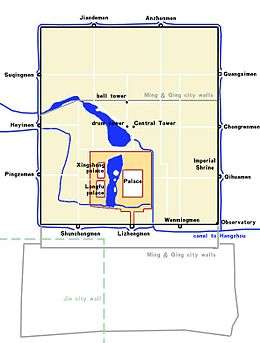Taiye Lake
| Taiye Lake | |||||||||
|
Zhongnanhai during the Qing Dynasty | |||||||||
| Chinese | 太液池 | ||||||||
|---|---|---|---|---|---|---|---|---|---|
| Literal meaning | Great Liquid Pond | ||||||||
| |||||||||
Taiye Lake or Pond was an artificial lake in imperial City, Beijing during the Jin, Yuan, Ming, and Qing dynasties of China. The beauty[1] and utility[2] of the lake was responsible for the siting of Kublai Khan's palace and the position of modern Beijing. It continues to exist but it is now known separately as the "North", "Central", and "South Sea"s, the three interconnected lakes just west of the Forbidden City in downtown Beijing. The northern lake makes up the public Beihai Park while the southern two are grouped together as Zhongnanhai, the headquarters for the Communist leadership of the People's Republic of China.
Taiye Lake was immortalized in the early 1410s when the Yongle Emperor commissioned The Eight Views of Beijing (北京八景圖), recording the capital's chief sites in poetry and painting in order to legitimize his removal of the imperial capital away from Nanjing. It is best remembered in China today from the scene of "Clear Waves at Taiye Lake" (太液清柭, Taiye Qingbo).[3]
Name
The literal meaning of the Chinese characters 太液池 is "Great Liquid Pool" or "Pond".
The name honors two separate lakes Taiye constructed in the early imperial capital of Chang'an (modern Xi'an). The first was excavated by the Han emperor Wu in the 1st century BC as part of his Jianzhang Palace (建章宫, Jiànzhānggōng). It and Kunming Lake were both necessary additions to the city's water supply after Wu's expansion of his capital.[2]
The second was excavated by Emperor Taizong of the Tang beside his father's Daming Palace, after the capital had been removed to the southeast to account for the damage to and growing salinity of the capital's original water sources.[2]
History

The lake was first constructed as part of the Jinshui River[4] canal system[5] under the Jurchen emperor Zhangzong. Although still within the limits of modern Beijing, the Jurchen capital of Zhongdu was located well south of the site, in a separate watershed.[2] Zhangzong constructed the Daning Palace (t 大寧宮, s 大宁宫, Dànínggōng, lit. "Palace of Great Peace"[6]) beside the new lake in 1179.[7]
During the Yuan dynasty, the Mongolian emperors abandoned the ruined site of Zhongdu and its more meager water sources in favor of the Gaoliang watershed.[2] The imperial engineers Liu Bingzhong and Guo Shoujing directed the construction of the new Imperial City of Khanbaliq (Marco Polo's Cambaluc & the Chinese Dadu) around Zhangzong's former palace and Lake Taiye, which was an important part of the capital's water supply.[2] The lake was expanded until it covered the area of the present northern and central "seas" and three palaces were built around it. The purity of the reservoir was protected by law: from its source at a spring on Yuquan Mountain to Lake Taiye, the Jinshui was given separate passes where it crossed other streams and commoners were forbidden to bathe, wash clothes, water livestock, or dump trash along its course.[8]
Under the Ming dynasty, construction on the present-day Forbidden City began in AD 1406 as part of the Yongle Emperor's relocation of the capital away from Nanjing. The new palace was south of the former Yuan one and the Taiye was expanded south along with it. The soil excavated from the lake and the fortress's moat were piled up to the palace's north to form the Mountain of Long Life (now known as Jingshan), burying the former Yuan site and improving the fengshui of the new one. The lake now comprised the three present-day "seas", which were divided by bridges, but continued to be known collectively as Taiye. The grounds were known as the West Park (西苑, Xīyuàn) and the Jiajing Emperor and others retreated to it to escape life at court.[9]
After the establishment of the Manchurian Qing dynasty in the 17th century, the new government reduced the extensive Ming-era parks around the lake, enclosed the smaller present-day area within walls attached to the imperial palace, and began calling the separate sections by their modern names. Successive emperors built pavilions and houses along the lake shore, where they held court during the summer.
See also
References
- ↑ Hou Renzhi. The Works of Hou Renzhi, pp. 56 ff. Peking Univ. Press (Beijing), 1998.
- 1 2 3 4 5 6 7 Du Pengfei & al. "History of Water Supply in Pre-Modern China" from Evolution of Water Supply through the Millennia, pp. 169 ff. Accessed 16 November 2013.
- ↑ Whiteman, Stephen. "From Upper Camp to Mountain Estate: Recovering Historical Narratives in Qing Imperial Landscapes", pp. 14 ff. Studies in the History of Gardens & Designed Landscapes: An International Quarterly. Taylor & Francis, 2013. Accessed 16 November 2013.
- ↑ The name paid tribute both to the new dynasty and to an earlier imperial canal in the Song capital Dongjing (modern Kaifeng).[2] Its literal meaning is "Gold Water".
- ↑ Hou, Eve. "Nine Dragons, One River: The Role of Institutions in Developing Water Pricing Policy in Beijing, PRC", p. 6. Univ. of British Columbia, 2001.
- ↑ Other names include the Taining (t 太寧宮, s太宁宫), the Shouan, and the Wanning (t 萬寧宮, s万宁宫) Palace.
- ↑ Rinaldi, Bianca. The Chinese Garden: Garden Types for Contemporary Landscape Architecture, p. 137. Walter de Gruyter, 2011. Accessed 16 November 2013.
- ↑ Du Pengfei. 中国古代的城市给水 ["Zhōngguó Gǔdàide Chéngshì Jǐshuǐ", "Water Supply of the Cities in Ancient China"]. China Historical Materials of Science and Technology, Vol. 1, No. 19, pp. 3–10. (Chinese)
- ↑ Wan, Maggie C.K. "Building an Immortal Land: The Ming Jiajing Emperor's West Park". Asia Major, 3rd Series, Vol. 22, No. 2 (2009), pp. 65-99. Accessed 15 November 2013.
.jpg)